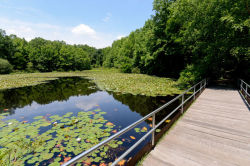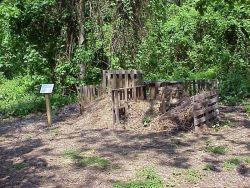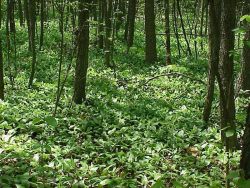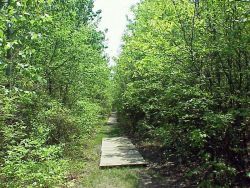Blue Heron Park
Blue Heron Park
This park is named after the gray-feathered predatory bird with a yellow bill, the blue heron (Ardea herodias). A hand-sculpted blue heron greets visitors at the entrance to the park.
The blue heron can be found throughout much of the New York area. Reaching more than four feet in height, it can typically be spotted standing at the edge of a pond or marsh, watching for fish or frogs. These animals make up their main diet, though they will also eat small mammals, reptiles, and smaller birds on occasion. Most herons migrate south in the fall, and those that remain in the north often fall victim to severe weather.
The City acquired this parkland in several segments between 1974 and 2001. By the time of its official dedication on October 22, 1996, a handful of concerned Staten Islanders had been working to preserve and protect the land for a full 33 years. Over time, their efforts were rewarded with the interest and hard work of many of their fellow residents and many Parks officials.
Blue Heron Park has become an outstanding wildlife sanctuary and educational resource. The years have seen it transformed from a wasteland filled with over 30 abandoned cars to a peaceful refuge of walking trails, meadows, ponds, streams, and woodlands. Visitors walking along any of the three main trails of the park will find an impressive array of wildflowers, including Wild columbine (Aquilegia Canadensis), Black-eyed Susan (Redbeckia hirta) and Jack-in-the-pulpit (Arisaema triphyllum).
The park also holds six ponds, among them the 1.75-acre Spring Pond and the 1.4-acre Blue Heron Pond, crossed by a popular footbridge. These kettle ponds were formed 15,000 years ago by the retreating Wisconsin glacier. Today they are teeming with marine life such as the curve-billed glossy ibis (Plegadis falcinellus), the black-crowned night heron (Nycticorax nycticorax), wood duck (Aix sponsa), owls (Strigiformes), osprey (Pandion haliaetus), turtles (Chelonia), and white water lilies (Nymphaea odorata). Spring peepers (Pseudacris crucifer) and tree frogs (Hylidae) find ample breeding grounds in the ponds, where nature enthusiasts flock to observe the thriving ecosystem.
The Visitors Center lies just inside the Poillon Avenue entrance to the park and contains several classrooms, exhibit areas, a library, an office, and rest rooms. It also has two observation decks with bird feeders and a mist net for bird banding - ideal conditions for bird watching and picnic tables for anyone to use. A wide variety of arts and educational programming is provided by the Urban Park Rangers and the Friends of Blue Heron, a community organization. The offerings include nature walks, classes, crafts, zoo animals, storytelling, and special holiday events.
In 1994, Councilman Vito J. Fossella provided $8,195 for surface investigations on Blue Heron Park, and then in 1996, $2,828,991, also provided by Fossella, went toward the construction of the Visitors Center, parking facilities, landscape restoration, and general habitat improvements. From 1997-2001, $703,000 provided by Councilman Jerome X. O’Donovan purchased two additions to the park.
Check out your park's Vital Signs
Clean & Safe
Green & Resilient
Empowered & Engaged Users
Share your feedback or learn more about how this park is part of a
Vital Park System









